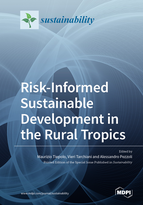Risk-Informed Sustainable Development in the Rural Tropics
A special issue of Sustainability (ISSN 2071-1050). This special issue belongs to the section "Hazards and Sustainability".
Deadline for manuscript submissions: closed (31 December 2020) | Viewed by 79364
Special Issue Editors
Interests: climate change adaptation; risk management; sustainable local development; urban and regional planning
Special Issues, Collections and Topics in MDPI journals
Interests: agrometeorology; climate services; disaster risk reduction
Special Issues, Collections and Topics in MDPI journals
Interests: meteorology; hydrology; marine engineering; marine navigation
Special Issues, Collections and Topics in MDPI journals
Special Issue Information
Dear Colleagues,
Efforts to achieve sustainable rural development are often thwarted by hydroclimatic disasters (droughts, flooding, storms, typhoons) which local communities are little prepared to tackle. Understanding these disasters, improving preparation, and strengthening governance have become equal priorities of the Sendai Framework for Disaster Risk Reduction (DRR) (2015). In recent years, however, the implementation of actions at local scale to achieve the objectives of the Sendai framework has come across innumerable obstacles. It is often the case that agricultural practices and local planning are not very risk-informed. Climatic information is absent or not accessible locally. Early warning systems and climate services are not constructed with and for the rural communities. Vulnerability and risk assessments are misaligned with risk prevention and preparedness local plans. Finally, the frequency and nature of DRR mainstreaming in municipal development plans is actually unknown. These deficiencies are particularly acute in the Tropics, where the majority of least developed countries are located and where there is, however, great potential for agricultural development.
As a consequence, this Special Issue is focused on rural Tropics, involving the local administrative level (individual municipalities and individual rural communities) and local scale (associations of smallholder farmers, groupings of specialist producers, cooperatives).
Our aim is to investigate information on the hydroclimatic risks (production, organization, accessibility) and the use of that information in agricultural practices and in local planning. We seek studies of individual cases (best practices), critical reviews, and theoretical papers originating from different academic fields dealing with a variety of topics, including:
- Open data on disasters;
- Non-stationary approaches to floods;
- Local climate scenarios;
- Early warning systems;
- Multihazard risk assessments for local planning;
- Hydroclimatic risk prevention, development plans, and aid at local scale;
- Capacity building for co-development of weather and climate services;
- Agrometeorological services for small farmers;
- Crop monitoring for food security;
- Climate change opportunities in agriculture.
References:
- Fiorillo, E.; Crisci, A.; Issa, H.; Morabito, M.; Tarchiani V. Recent changes of floods and related impacts in Niger based on the ANADIA Niger flood database. Climate 2018
- Deichmann, U., Goyal, A.; Mishra, D. Will digital technologies transform agriculture in Developing Countries? World Bank Policy Research Working Paper 2016, 7669
- Brasseur, G.P.; Gallardo, L. Climate services: Lessons learned and future prospects, Earth’s Future 2016, 4, 79–89
- Ouedraogo, M.; Barry, S.; Zougmoré, RB.; Partey, S.T.; Somé, L.; Baki G. Farmers’ willingness to pay for climate information services: evidence from cowpea and sesame producers in Northern Burkina Faso. Sustainability 2018, 10, 611
- Tall, A.; Coulibaly, J.Y.; Diop, M. Do climate services make a difference? A review of evaluation methodologies and practices to assess the value of climate information services for farmers: implication s for Africa. Climate Services 2018, 11, 1-12
- Pasquini, L.; Ziervogel, G.; Cowling R.M.; Shearing C. What enables local governments to mainstream climate change adaptation? Lessons learned from two municipal case studies in the Western Cape, South Africa. Climate and Development 2015, 7(1)
- Lyles, W.; Berke, P.; Smith, G. A comparison of local hazard mitigation plan quality in six states, USA. Landscape and Urban Planning 2014, 122, 89-99
- Horney, J., Nguyen, M., Salvesen, D., Dwyer, C., Cooper, J. Berke, P. Assessing the quality of rural hazard mitigation plans in the Southeastern United States. J Planning Education Research 2017 37(1), 56-65
- Lavell, A.; Maskrey, A. The future of disaster risk management. Environmental Hazards 2014, 13(4), 267–280
- Thomalla, F.; Boyland, M.; Johnson, K.; Ensor, J.; Tuhkanen, H.; Gerger Swartling, Å.; Wahl, D. Transforming development and disaster risk. Sustainability 2018, 10(5), 1458
- Steenkamp, P.J.; Van Heerden, H.; Van Schalkwyk, O.L. Ecological suitability modeling for anthrax in the Kruger National Park, South Africa, PloS one 2018, 13(1)
- Zia A.; Wagner, C.H. Mainstreaming early warning systems in development and planning processes: Multilevel implementation of Sendai framework in Indus and Sahel. Int J Disaster Risk Sci 2015 6, 189-199
- Gautam, D.K.; Phaiju, A.G. Community based approach to flood early warning in West Rapti river basin in Nepal. J integrated Disaster Risk Management 2013, 3(1), 155-169
- Spielman, D.J.; Ekboir, J.; Davis, K.; Ochieng, C.M.O. An innovation systems perspective on strengthening agricultural education and training in Sub-Saharan Africa, Agricultural Systems 2008, 98, 1-9
- Altieri, M.A.; Nicholls, C.I. The adaptation and mitigation potential of traditional agriculture in a changing climate. Climatic Change 2017, 140, 33-4
- Meijer, S.S.; Catacutan, D.; Ajayi, O.C.; Sileshi, G.W.; Nieuwenhuis, M. The role of knowledge, attitudes and perceptions in the uptake of agricultural and agroforestry innovations among smallholder farmers in sub-Saharan Africa, International Journal of Agricultural Sustainability, 2015, 13:1, 40-54.
Prof. Dr. Maurizio Tiepolo
Dr. Vieri Tarchiani
Prof. Dr. Alessandro Pezzoli
Guest Editors
Manuscript Submission Information
Manuscripts should be submitted online at www.mdpi.com by registering and logging in to this website. Once you are registered, click here to go to the submission form. Manuscripts can be submitted until the deadline. All submissions that pass pre-check are peer-reviewed. Accepted papers will be published continuously in the journal (as soon as accepted) and will be listed together on the special issue website. Research articles, review articles as well as short communications are invited. For planned papers, a title and short abstract (about 100 words) can be sent to the Editorial Office for announcement on this website.
Submitted manuscripts should not have been published previously, nor be under consideration for publication elsewhere (except conference proceedings papers). All manuscripts are thoroughly refereed through a single-blind peer-review process. A guide for authors and other relevant information for submission of manuscripts is available on the Instructions for Authors page. Sustainability is an international peer-reviewed open access semimonthly journal published by MDPI.
Please visit the Instructions for Authors page before submitting a manuscript. The Article Processing Charge (APC) for publication in this open access journal is 2400 CHF (Swiss Francs). Submitted papers should be well formatted and use good English. Authors may use MDPI's English editing service prior to publication or during author revisions.
Keywords
- climate services
- disaster risk reduction
- drought
- early warning systems
- emergency plans
- flooding
- local development plans
- loss and damages open data
- multihazard
- risk assessment
- risk prevention
- risk reduction plans
- vulnerability assessment








